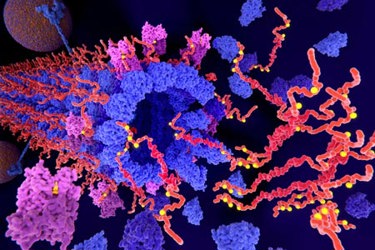J&J Taps Tau-Based Diagnostics To Improve Alzheimer's Disease Trial Design And Enrollment
By Fiona Elwood, Ph.D., vice president, disease area stronghold leader, neurodegeneration, Johnson & Johnson

What if we could stop Alzheimer’s disease (AD) before it starts? For years, that question has driven the work of researchers and clinicians alike, and until recently, it felt aspirational. But over the past decade, advances in our understanding of the disease have laid the foundation for meaningful, biology-driven progress. AD remains one of the most complex health challenges of our time, but with deeper insight into its pathology and the development of precision tools, the idea of stopping the disease before it starts is no longer theoretical. It’s within reach.
We’ve made significant strides in identifying and tracking the biological markers of AD – progress that’s opening new opportunities to detect its earliest signals and intervene before irreversible damage takes hold. The approval of amyloid-targeting therapies marked an important step forward, but an immense unmet need remains for safe and effective therapies across the spectrum of this devastating disease.
Diagnostics Bring Precision To AD Research
Until recently, AD was diagnosed based solely on clinical evaluations and cognitive testing, without the ability to measure the underlying pathology. These techniques detect cognitive symptoms only after irreversible neurodegeneration has set in, limiting the window for early disease intervention. Moreover, these assessments can vary depending on how "good" a day the patient is having, as well as between individual raters, introducing variability into the diagnostic process. Today, advances in neuroscience and biomarker discovery are transforming our ability to detect AD earlier. It’s now possible to detect amyloid and tau through positron emission tomography (PET) imaging, and emerging biomarkers, such as highly sensitive blood-based assays that indicate levels of tau and amyloid pathology, allow us to identify signs of early AD.
These advances offer more definitive, minimally invasive, and scalable methods for identifying Alzheimer's pathology reliably, even before symptoms appear, and they are transforming AD research by enabling biomarker-driven clinical strategies. Rather than evaluating broad patient populations, researchers can now identify and enroll subgroups defined by pathological profiles, allowing therapies to be tested in the most appropriate populations. By enrolling patients at different disease stages, from preclinical to mild cognitive impairment to established Alzheimer’s, trials can be better aligned with therapeutic goals – whether that’s prevention, slowing progression, or improving cognition and function. And they enable better targeting of the biological processes occurring in the brain at that stage of disease.
Unlike traditional clinical assessments that rely on subjective cognitive evaluations and can yield uncertain results, biomarker-based diagnostics provide objective, quantifiable measures of disease pathology, leading to more definitive diagnoses. Compared to PET imaging, which requires specialized facilities and incurs significant costs, blood-based assays offer a minimally invasive, scalable alternative that could significantly broaden access to early, accurate detection.
We’re leveraging these precision approaches to detect, analyze, and track the spread of tau pathology. In our ongoing trials studying disease progression in patients with early AD, we’re using a p217 tau blood test invented by our biomarker team to prescreen participants for eligibility. This approach helps streamline recruitment by quickly identifying individuals likely to have tau pathology, reducing screen failure rates and accelerating trial enrollment. It also spares patients who are unlikely to qualify from undergoing unnecessary PET scans, reserving more resource-intensive imaging for the most clinically relevant populations.
As the field continues to develop and refine powerful, more convenient tools for screening and diagnosis, we may be able to identify patients even earlier, more definitively, and more reliably. This could transform the landscape of clinical trials and treatment in AD — or possibly reshape the future of routine clinical practice.
Tau-Focused Clinical Trials Illuminate New Options
Because of its direct link to AD disease progression, tau is increasingly recognized as a critical treatment target for AD, with the potential to serve as a “reasonably likely surrogate endpoint” recognized by the FDA.1 Foundational data show that tau pathology correlates closely with neurodegeneration and may predict future cognitive decline, and that early intervention is likely the best way to stop AD. To establish tau as a reasonably likely surrogate endpoint, ongoing studies must demonstrate a consistent relationship between changes in tau pathology and clinical outcomes. This evidence is essential to support broader acceptance in both research and regulatory settings.
Much of today’s clinical research around tau in AD is focused on active and passive immunotherapies. At Johnson & Johnson, we’re conducting Phase 2b trials for two therapeutic candidates that target tau in preclinical and early AD. Both investigational therapies received Fast Track designations by the FDA, and the U.K.’s Medicines and Healthcare Products Regulatory Agency recently awarded one of these tau candidates with an Innovation Passport, the first step to accelerating a therapy’s time to market as part of the Innovative Licensing and Access Pathway. These designations reflect the growing urgency to advance novel and transformational therapies that, if approved, will have the potential to safely alter the course of this devastating disease.
Tracking Tau To Monitor And Address AD Pathology
We’re entering a significant breakthrough period in AD research and development, one marked not only by scientific progress but by a fundamental shift in what’s possible. Precision tools that allow us to trace biomarkers like tau over years or even decades may prove to be among our most powerful assets in understanding AD and developing therapies that slow symptoms or even halt disease progression. Molecular targets and precision tools, paired with an increasingly deeper understanding of the pathophysiology behind AD, are equipping us to help address the significant unmet medical need still faced by patients and families across all stages of the disease.
References:
- Makin S. The future of Alzheimer’s treatment. Nature. Accessed April 2025. https://www.nature.com/articles/d41586-025-01102-2.
About The Expert:
 Fiona Elwood, Ph.D., is the neurodegenerative disease area stronghold (das) leader at Johnson & Johnson and has extensive experience in neuroscience and neurodegenerative research and development. She brings deep expertise in molecular mechanisms of neurodegeneration, including in tau biology, and the use of human cell models and advanced screening approaches to support novel target identification and validation.
Fiona Elwood, Ph.D., is the neurodegenerative disease area stronghold (das) leader at Johnson & Johnson and has extensive experience in neuroscience and neurodegenerative research and development. She brings deep expertise in molecular mechanisms of neurodegeneration, including in tau biology, and the use of human cell models and advanced screening approaches to support novel target identification and validation.
Prior to joining Johnson & Johnson, Fiona was most recently interim global head of neuroscience and head of neurodegeneration at Novartis Institute for Biomedical Research. Before moving to Novartis, she spent nearly 10 years at Merck Research Laboratories in positions of increasing responsibility.
Fiona received her doctorate in neuroscience from the University of London, United Kingdom, and completed her postdoctoral work in neuroscience at Stanford University.
